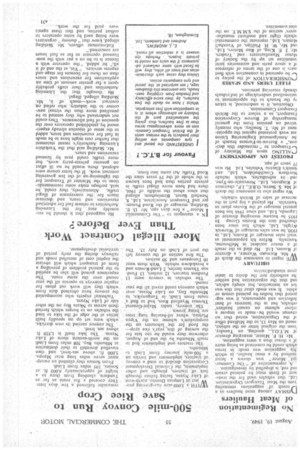500-mile Convoy Run to Save Rice Crop
Page 33

If you've noticed an error in this article please click here to report it so we can fix it.
WITH. a .3.000-acre rice-gr:ae, mg pro jeCt at Lirripasi Dambo, north-west: of Lake Nyasa, facing 'failure through lack of tractors, ploughs and other implements, the Colonial Development Corporation decided to send: a convoy of tractOrs, implements and lorries on a -.500-mile journey froth Lindi to Mbatiaba:
The -tractors and implements had to reacti-Mbamba by the end .of August, otherwise they would -be too late fOr the sowing of this, Jeer's rice crop--ethe food for the labourers on the corporation's Schenne 'art the yipya Plateau, where oil-bearing lung trees
are ,'being 'grown. • ." . '
The convoy uncle] Major-Ge.neral Thomas Wynford ReeS, had to find a' route from Lindi, in Tanganyika, to Mbamba Day, on Lake Nyasa, over • which convoys Could travel all the year round, The vehicles in convoy were 13 Forclson traciors, 12 trailers, 13 Fordson Thames lorries, 2 Land-Rovers and a breakdown vehicle. With them went 10 Europeans and 50 natives.
The first section of the convoy left the port of Lindi on July 15. The remainder followed a few days later. They covered a flat route as far as Tunduru, climbing from there to it height of approximately 4,000 ft. at Sonjea, 395 miles from Lindi, From Soniea they climbed an escarpment seven miles long near Mpapa, 5,000 ft above sea-level, and then travelled downhill to their destination at Mbamba Bay, 508 miles from Lindi on the north-eastern shore of Lake • Nyasa. The lake itself is 1,550 ft above sea level.
The convoy carried its own derricks, which were set up on speedily built jetties at the edge of the lake to load the vehicles on to barges which ferried them across to Nkata Bay on the other side of Lake Nyasa.
Technical experts who accompanied the convoy have obtained data from which, they will work out plans for regular convoys to operate all the year round over the ,same route. The experience gained will also be applied to the general problem of providing a
• form •of transport which will obviate the capital cost of metalled roads and railways during the early period of . territorial development.




















































































